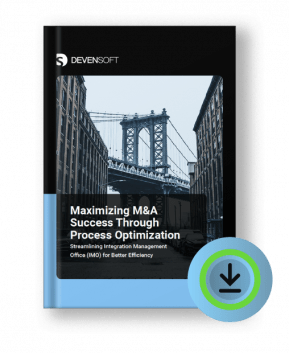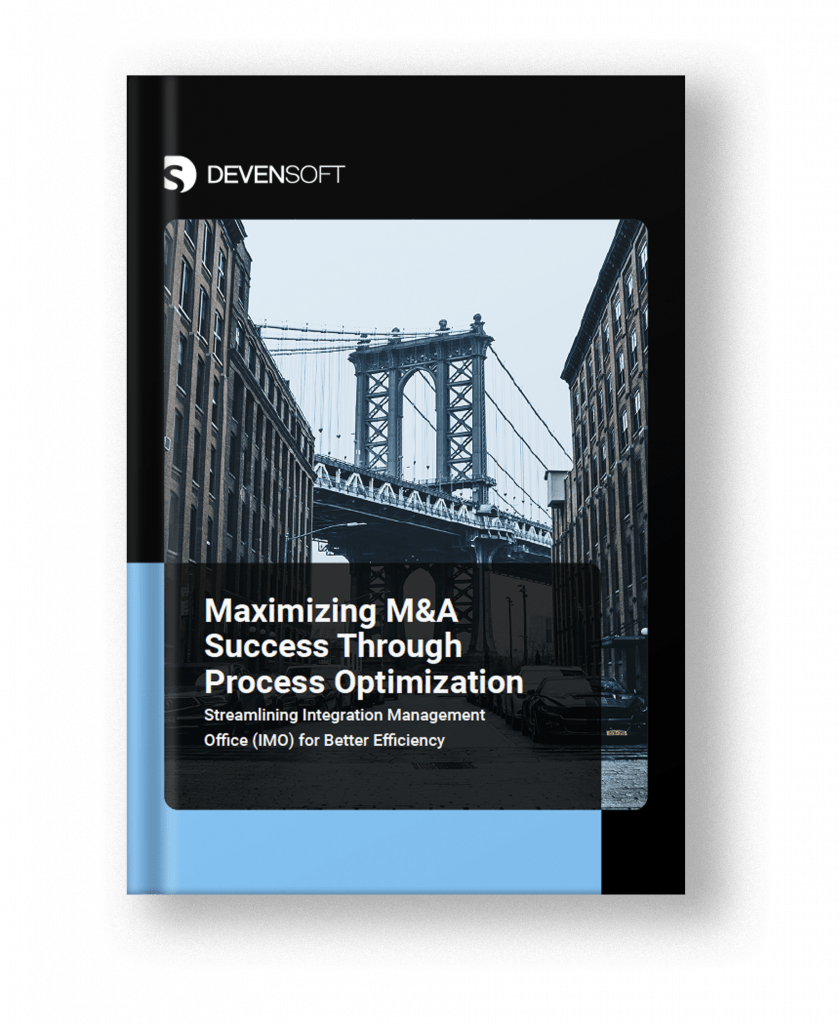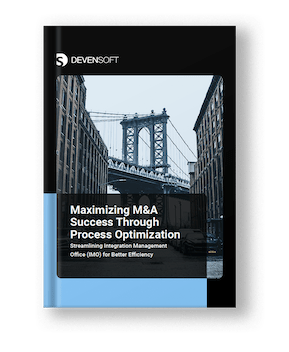Streamlining Integration Management Office (IMO) for Better Efficiency
Mergers and Acquisitions (M&A) are complex undertakings that require careful planning and execution. One of the critical components of M&A is the Integration Management Office (IMO). This chapter provides an overview of IMO, its definition, and importance in M&A.
Definition of Integration Management Office
The Integration Management Office (IMO) is a dedicated team responsible for managing the integration of two or more companies during M&A. The IMO ensures that the integration process is efficient, effective, and successful. The IMO is responsible for developing integration plans, timelines, and budgets, as well as identifying and managing risks.
An IMO may comprise members from both the acquiring and the acquired companies. The team may include employees from various departments, such as human resources, finance, operations, and IT.

Importance of Integration Management Office in M&A
The IMO plays a crucial role in M&A by ensuring that the integration process is successful. Without an IMO, M&A may result in significant disruptions, delays, and even failure. The IMO helps to minimize the risks associated with M&A by providing a structured approach to integration.
The IMO also helps to ensure that the benefits and synergies of M&A are realized. These benefits may include cost savings, increased revenue, market share, and improved competitiveness.
Challenges in Integration Management Office
Despite the benefits of an IMO, there are several challenges associated with it. This chapter highlights some of the common challenges faced by IMO teams during M&A.
Cultural Differences
One of the significant challenges faced by IMO teams is cultural differences between the acquiring and the acquired companies. Cultural differences may include differences in language, communication styles, work ethics, and organizational structure.
Cultural differences may lead to misunderstandings, conflicts, and resistance to change. IMO teams must be aware of these differences and develop strategies to mitigate their impact on the integration process.
Here are 5 potential implications if the IMO fails to address cultural differences between the acquiring and acquired companies during the integration process:
- Decreased Employee Morale: Cultural differences can create tension and conflict between employees from the two companies, which can lead to a decrease in overall employee morale and job satisfaction.
- Reduced Productivity: Cultural differences can result in misunderstandings and communication breakdowns, leading to delays and mistakes in the integration process. This can ultimately result in a decrease in productivity.
- Loss of Key Talent: If cultural differences are not addressed, employees may become disengaged or leave the company altogether. This can result in a loss of key talent and institutional knowledge.
- Negative Impact on Customer Relations: If the integration process is not managed effectively, it can negatively impact customer relations, resulting in a loss of business and revenue.
- Decreased ROI: If the integration process is not successful due to cultural differences, it can lead to increased costs, delays, and ultimately a decreased return on investment (ROI) for the acquiring company.

Case studies of M&A failures due to cultural differences
- HP-Compaq Merger: The HP-Compaq merger in 2002 was driven by the desire to create a technology giant that could compete with IBM. However, the two companies had vastly different cultures and business models, with HP focused on printers and imaging and Compaq focused on computers and servers. The cultural differences led to significant internal conflict, with the HP board narrowly approving the merger by a single vote. The merged company struggled to integrate its disparate businesses and lost market share to competitors like Dell.
- DHL-Danzas Merger: In 1999, DHL acquired Danzas, a Swiss freight company, to expand its global reach. However, the two companies had different organizational structures and cultures, with DHL more focused on speed and efficiency and Danzas more focused on quality and reliability. These cultural differences led to clashes over decision-making and management styles, with DHL ultimately failing to integrate Danzas successfully.
- Quaker Oats-Snapple Merger: In 1994, Quaker Oats acquired Snapple, a popular beverage company, for $1.7 billion. However, the merger was plagued by cultural differences, with Quaker Oats being a large, established food company and Snapple being a smaller, more entrepreneurial beverage company. The two companies had different cultures and business models, with Snapple relying on a unique marketing approach and Quaker Oats focused on mass-market appeal. These cultural differences led to a lack of understanding and communication between the two companies, with the merged company struggling to integrate Snapple successfully.
Communication Issues
Communication is critical during M&A, and communication breakdowns can have significant consequences. Communication issues may include language barriers, misinterpretation of messages, and lack of transparency.
Effective communication strategies must be developed to ensure that all stakeholders are informed and engaged throughout the integration process. The IMO must ensure that communication channels are open, and information is shared in a timely and transparent manner.
Here are 5 potential implications if the IMO fails to address communication issues during the M&A integration process:
- Misunderstandings and Errors: Communication breakdowns can lead to misunderstandings and errors in the integration process, resulting in wasted time, resources, and money.
- Decreased Employee Morale: A lack of communication or miscommunication can lead to confusion and uncertainty among employees, which can negatively impact morale and job satisfaction.
- Loss of Key Talent: If communication issues are not addressed, key talent may become disengaged or leave the company, resulting in a loss of critical knowledge and expertise.
- Negative Impact on Customer Relations: Poor communication can result in negative customer experiences, damaging the company’s reputation and resulting in lost business.
- Legal and Regulatory Risks: Failure to communicate effectively during the M&A integration process can lead to legal and regulatory risks, including non-compliance with laws and regulations, lawsuits, and reputational damage.
Case studies of M&A struggles due to ineffective communications
There are several real-world examples and case studies where communication breakdowns during M&A integration have led to negative consequences. Here are a few examples:
- DaimlerChrysler Merger: In 1998, Daimler-Benz and Chrysler Corporation announced a “merger of equals” to create DaimlerChrysler. However, cultural and communication differences between the two companies created friction and led to a lack of trust. The failure to address these issues eventually led to the merger’s collapse, with Daimler selling Chrysler in 2007 at a significant loss.
- HP-Compaq Merger: In 2001, Hewlett-Packard (HP) announced its merger with Compaq, a major computer hardware manufacturer. However, the integration process was plagued by communication breakdowns and a lack of clarity around the new company’s strategic direction. This led to internal conflicts and delays in the integration process, ultimately resulting in a decline in HP’s market share.
- AOL-Time Warner Merger: In 2000, AOL announced its merger with Time Warner, which was then one of the largest media companies in the world. However, cultural differences and communication breakdowns between the two companies created significant challenges, with AOL executives feeling marginalized by Time Warner’s corporate culture. The merger eventually failed, with AOL-Time Warner splitting into separate companies in 2009.

Resistance to Change
Resistance to change is a common issue during M&A. Employees may be resistant to changes in their roles, responsibilities, and work environment. Resistance to change may lead to decreased productivity, low morale, and even employee turnover.
The IMO must develop change management strategies to address resistance to change. These strategies may include communication, training, and incentives.
Here are 5 implications if the IMO fails to address resistance to change during M&A:
- Decreased Productivity: Employees who are resistant to change may not be as productive as they were before the M&A, which can affect the overall productivity of the organization.
- Low Morale: Resistance to change can also lead to low morale among employees, as they may feel uncertain about their roles and the future of the organization.
- Employee Turnover: If employees are not happy with the changes brought about by the M&A and feel that their concerns are not being addressed, they may choose to leave the organization.
- Increased Costs: If the IMO fails to address resistance to change, it may result in increased costs for the organization, such as the cost of rehiring and training new employees.
- Failed Integration: Failure to address resistance to change can ultimately lead to a failed integration, as employees may not be fully engaged and committed to making the M&A a success.
Case studies of M&A struggles from a resistance to change
These examples highlight the importance of addressing resistance to change during M&A and the potential consequences of failing to do so.
- The Disney-Fox Merger: When Disney acquired Fox in 2019, there was significant resistance from Fox employees to the changes that would come with the acquisition. This included concerns over job security and the integration of the two company cultures. As a result, Disney had to work to address these concerns and ensure that the integration was successful.
- The Sprint-T-Mobile Merger: The merger between Sprint and T-Mobile faced significant resistance from labor unions and antitrust regulators who were concerned about the impact on jobs and competition in the wireless industry. While the merger ultimately went through, the resistance to the deal highlighted the importance of addressing concerns from stakeholders during M&A.
- The United Airlines-Continental Airlines Merger: When United Airlines and Continental Airlines merged in 2010, there was significant resistance from Continental employees to the changes that would come with the acquisition. This included concerns over job security and changes to their work environment. As a result, the integration took longer than expected, and it took time for the two company cultures to merge successfully.
- The Bank of America-Merrill Lynch Merger: This merger is another example of a failed integration due in part to resistance to change. Employees at Merrill Lynch were resistant to the changes brought about by the merger, including changes to their compensation structure. This led to low morale and increased turnover, which ultimately affected the success of the integration.
Best Practices in Integration Management Office
Despite the challenges faced by IMO teams, there are several best practices that can help to ensure a successful integration process. This chapter highlights some of these best practices.
Establish Clear Objectives
Clear objectives must be established at the outset of the integration process. Objectives should be specific, measurable, achievable, relevant, and time-bound (SMART). Objectives should be aligned with the overall strategic goals of the organization.
Clear objectives help to ensure that all stakeholders are aligned and working towards a common goal. Objectives also provide a basis for measuring progress and success.
Here are 10 examples of setting clear objectives:
- Increase revenue by 20% in the next fiscal year by expanding into new markets.
- Reduce operational costs by 15% within the next six months by implementing lean management practices.
- Increase customer satisfaction ratings by 10% within the next year by improving product quality and customer service.
- Increase employee engagement scores by 15% within the next quarter by implementing new employee development programs.
- Expand the company’s product line by introducing three new products within the next year.
- Increase market share by 5% within the next six months by acquiring a competitor.
- Improve the company’s brand recognition by launching a new marketing campaign that increases brand awareness by 20% within the next quarter.
- Increase website traffic by 25% within the next six months by implementing search engine optimization (SEO) strategies.
- Improve the company’s sustainability practices by reducing carbon emissions by 20% within the next year.
- Increase the company’s social media engagement by 30% within the next quarter by launching a new social media marketing campaign.
Effective Communication Strategies
Effective communication strategies are critical during the integration process. Communication should be timely, transparent, and two-way. Communication channels should be open, and all stakeholders should be informed and engaged throughout the process.
Effective communication strategies help to minimize misunderstandings, conflicts, and resistance to change. Communication also helps to build trust and confidence among stakeholders.
Here are 10 examples of communication strategies that can be used during an integration process:
- Conduct regular town hall meetings to keep employees informed about the integration process and to address any concerns they may have.
- Create an integration website or portal where stakeholders can access information about the integration process, including timelines, milestones, and key updates.
- Develop a communication plan that outlines the communication channels, messages, and frequency of communication.
- Establish an integration team that is responsible for managing communication and ensuring that all stakeholders are informed and engaged throughout the process.
- Use video and other multimedia tools to communicate key messages, such as the vision and mission of the combined organization.
- Host employee focus groups to gather feedback and input from employees on the integration process.
- Develop training programs to help employees understand the changes that will occur because of the integration and to provide them with the skills and knowledge they need to succeed in their new roles.
- Provide regular updates to customers, vendors, and other external stakeholders to keep them informed about the integration process and to address any concerns they may have.
- Use social media channels to communicate key messages and updates about the integration process.
- Assign communication champions within each business unit to ensure that information is shared effectively and that all stakeholders are kept informed.

Develop Cultural Awareness
Cultural awareness is essential during the integration process, particularly when dealing with cultural differences. The IMO must develop cultural awareness by understanding the cultural differences between the acquiring and acquired companies.
The IMO should develop strategies to mitigate the impact of cultural differences, such as providing cultural training, developing cross-cultural teams, and promoting cultural diversity.
Here are ten ways to develop cultural awareness:
- Conduct research: Gather information about the culture(s) you will be working with, including history, customs, and social norms.
- Learn the language: Learning the language spoken by the other company will help you communicate more effectively and show respect for their culture.
- Foster an inclusive workplace culture: Encourage employees to learn about and appreciate different cultures. Celebrate diversity and promote cultural exchange.
- Develop cross-cultural teams: Create teams that bring together individuals from different cultures to work together and learn from one another.
- Participate in cultural events: Attend cultural events to learn more about the culture(s) you will be working with and to build relationships with people from those cultures.
- Provide cultural training: Offer training to employees on how to work with people from different cultures, including communication styles, customs, and etiquette.
- Hire cultural consultants: Bring in experts from the culture(s) you will be working with to provide guidance and advice.
- Encourage open communication: Foster an environment where employees feel comfortable discussing cultural differences and asking questions.
- Address cultural stereotypes: Educate employees on the dangers of cultural stereotypes and encourage them to be open-minded and non-judgmental.
- Promote cultural diversity: Encourage diversity in the workplace, including hiring employees from different cultures and backgrounds.
Process Optimization in Integration Management Office
Process optimization is critical during M&A to ensure that the integration process is efficient and effective. This chapter highlights some of the steps that IMO teams can take to optimize the integration process.
Assess Current Processes
The first step in process optimization is to assess the current integration processes. The IMO should identify the strengths and weaknesses of the current processes and develop a plan to address any issues.
The assessment should include a review of the integration plan, timelines, roles and responsibilities, communication channels, and performance metrics.
Consider these questions
- Is the integration plan aligned with the overall strategic goals of the organization?
- Are the timelines realistic and achievable?
- Have all stakeholders been identified and assigned roles and responsibilities?
- Are the roles and responsibilities clearly defined and communicated to all stakeholders?
- Are there any gaps or overlaps in the roles and responsibilities?
- Is the communication plan comprehensive and effective?
- Are there any language or cultural barriers that may affect communication?
- Are the communication channels open and accessible to all stakeholders?
- Is there a process in place for addressing issues and conflicts?
- Are performance metrics established and aligned with the overall strategic goals?
- Are the performance metrics specific, measurable, achievable, relevant, and time-bound (SMART)?
- Are the performance metrics tracked and reported regularly?
- Are there any opportunities for automation or streamlining of processes?
- Are there any potential risks or obstacles that may affect the integration process?
Identify Bottlenecks
Once the current processes have been assessed, the IMO should identify bottlenecks in the integration process. Bottlenecks are areas of the integration process where delays and disruptions occur.
The IMO should develop strategies to address bottlenecks, such as reallocating resources, changing processes, or developing contingency plans.
Here are 5 strategies that the IMO can consider to address bottlenecks:
- Reallocation of resources: The IMO can redistribute resources to address bottlenecks. For example, if a particular department is overloaded, additional resources can be assigned to alleviate the bottleneck.
- Process redesign: The IMO can redesign processes to remove bottlenecks. This can include the automation of processes, streamlining of approval processes, or restructuring of the organization.
- Contingency planning: The IMO can develop contingency plans to address potential bottlenecks. For example, if a key employee is unavailable, a contingency plan can be developed to ensure that the integration process is not disrupted.
- Collaboration: The IMO can encourage collaboration between departments to reduce bottlenecks. This can include cross-functional teams or task forces that work together to address specific integration challenges.
- Continuous improvement: The IMO can adopt a continuous improvement approach to address bottlenecks. This involves regularly reviewing the integration process and making improvements based on feedback and performance metrics.
Streamline Processes
The final step in process optimization is to streamline the integration processes. Streamlining involves simplifying processes, eliminating redundancies, and reducing delays.
The IMO should use process improvement techniques such as Lean Six Sigma to streamline the integration process. Streamlining the process helps to reduce costs, improve efficiency, and increase the chances of a successful integration.
Here are five other process improvement techniques that IMO teams can consider:
- Business Process Reengineering (BPR): This technique involves redesigning processes from scratch to achieve significant improvements in performance, efficiency, and effectiveness.
- Total Quality Management (TQM): This is a management approach that emphasizes continuous improvement in all aspects of the organization, including processes, products, and services.
- Kaizen: This technique focuses on continuous improvement through small, incremental changes in processes and operations.
- Agile: This is an iterative approach that emphasizes flexibility and adaptability in the face of changing circumstances.
- Business Process Management (BPM): This is a holistic approach to managing and optimizing business processes, including process design, execution, monitoring, and improvement.
Tools for Integration Management Office
Several tools are available to support the IMO during M&A. This chapter highlights some of the common tools used by IMO teams.
Project Management Software
Project management software, such as Microsoft Project, can help IMO teams to manage the integration process. Project management software provides tools for developing project plans, tracking progress, and managing resources.
Project management software also provides a platform for collaboration and communication among team members.

Collaboration Tools
Collaboration tools, such as Microsoft Teams or Slack, can help IMO teams to communicate and collaborate effectively. Collaboration tools provide a platform for messaging, video conferencing, file sharing, and project management.
Collaboration tools help to ensure that all stakeholders are informed and engaged throughout the integration process.
Performance Metrics
Performance metrics are critical for measuring progress and success during the integration process. Key performance indicators (KPIs) should be established at the outset of the integration process and tracked throughout.
KPIs may include financial metrics, such as revenue and cost savings, as well as non-financial metrics, such as employee satisfaction and customer retention.
Leveraging a Consolidated Solution
To reduce risks, increase deal success rate, and excellence with on-time mergers, consider leveraging an M&A-specific solution instead of one-off products like Microsoft Project, Asana, or Slack. A consolidated solution that combines project management software, collaboration tools, and performance metrics into one centralized and secure platform can provide several benefits to the IMO team.
First, a centralized platform can help to streamline communication and collaboration among team members. All stakeholders can access the same information, reducing the risk of miscommunication and misunderstandings.
Second, a consolidated solution can provide real-time visibility into project progress and performance metrics. This can help to identify bottlenecks and address issues promptly, improving efficiency and reducing delays.
Finally, a secure platform can help to protect sensitive data and confidential information, such as financial data and intellectual property. This can help to mitigate the risks associated with M&A, such as data breaches and information leaks.
Here are some common ROI metrics that can be used to evaluate the success of an IMO team’s efforts which are more often achieved with a consolidated solution, such as Devensoft. These include:
- Increased revenue or profitability: M&A deals are often aimed at increasing revenue or profitability, and a successful integration can help achieve these goals.
- Cost savings: M&A deals can also be aimed at reducing costs through economies of scale, and a successful integration can help achieve these cost savings.
- Improved customer satisfaction: A successful integration can help improve customer satisfaction by providing better products and services.
- Employee retention and satisfaction: A successful integration can help improve employee retention and satisfaction by providing better career opportunities, training, and benefits.
- Increased market share: A successful integration can help increase market share by combining the strengths of both companies.

Key Takeaways
This article aims to provide comprehensive insights into the Integration Management Office and its significance in M&A. The key takeaways and best practices outlined here can help organizations to overcome the challenges of integration and achieve successful outcomes.
- Emphasize on the definition and importance of IMO in M&A. The Integration Management Office helps organizations to integrate various business units, strategies, systems, and cultures smoothly and efficiently.
- Shine light on the significant challenges faced by IMO teams, such as the lack of resources, inadequate communication, and resistance to change.
- Delve into best practices for IMO, including having a clear integration plan, establishing a governance structure, engaging stakeholders, and measuring success.
- Highlight the significance of process optimization in IMO, which entails streamlining processes, removing redundancies, and automating manual tasks.
- Discuss the tools necessary for IMO, such as project management software, data visualization tools, and collaboration platforms.
Future Trends in Integration Management Office
Additionally, the future trends in IMO can help organizations to stay ahead of the curve and leverage emerging technologies and sustainability practices to enhance their integration process. Future trends in IMO include the use of AI and automation to streamline the integration process, the development of more sophisticated communication tools, and increased focus on sustainability and social responsibility.
- AI and automation can help IMO teams to analyze data, identify patterns, detect anomalies, and make predictions, thus reducing the time and effort required for integration.
- The development of more sophisticated communication tools that can enhance collaboration and knowledge sharing among stakeholders. For instance, Virtual Reality (VR) and Augmented Reality (AR) can simulate real-life scenarios and provide immersive experiences that enable stakeholders to visualize the integration process and identify potential gaps.
- The increased focus on sustainability and social responsibility in IMO. Organizations are becoming more aware of their impact on the environment and society, and they are taking measures to minimize their carbon footprint, promote diversity and inclusion, and support local communities.
In conclusion, a well-executed Integration Management Office (IMO) can be a game-changer for organizations undergoing mergers and acquisitions. By leveraging the best practices and tools discussed in this eBook, IMO teams can navigate the complex integration process with ease and achieve successful outcomes. Additionally, keeping an eye on emerging trends and technologies can help organizations stay ahead of the curve and ensure that their integration process remains efficient, sustainable, and socially responsible. As organizations continue to grow and expand, the role of IMO will become increasingly critical in ensuring that these expansions are successful and sustainable in the long run.
Explore how to digitally transform your post-merger integration process with Devensoft.
Devensoft is M&A-purpose-built SaaS solution designed to facilitate mergers and acquisitions by simplifying and consolidating all the critical functions of an organization into a user-friendly interface.
Devensoft helps strategic business leaders who understand the importance of realizing deal value quickly by centralizing and securing their M&A journey. Our solution creates an organization that excels at deal success with transparency, priorities, and progress embedded into the fabric of all strategic initiatives.
Unlike other solutions or manual approaches, Devensoft has the experience and configurability to solve your unique M&A challenges and the capabilities and scalability to get you where you want to go.





